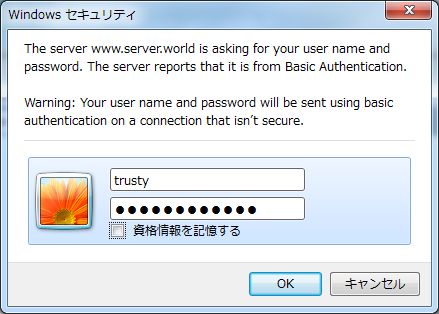|
Use Basic Auth
2014/04/30 |
|
Enable Basic Authentication to limit access on specific web pages.
|
|
| [1] | For example, set Basic Authentication setting under the directory [/var/www/html/auth-basic]. |
|
root@www:~#
apt-get -y install apache2-utils
root@www:~#
vi /etc/apache2/sites-available/auth-basic.conf # create new
<Directory /var/www/html/auth-basic>
AuthType Basic
AuthName "Basic Authentication"
AuthUserFile /etc/apache2/.htpasswd
require valid-user
</Directory>
# add a user : create a new file with "-c" ( add the "-c" option only for the initial registration ) root@www:~# htpasswd -c /etc/apache2/.htpasswd trusty New password: # set password Re-type new password: Adding password for user trusty mkdir /var/www/html/auth-basic root@www:~# a2ensite auth-basic Enabling site auth-basic. To activate the new configuration, you need to run: service apache2 reloadroot@www:~# /etc/init.d/apache2 restart * Restarting web server apache2 ...done. # create a test page
root@www:~#
vi /var/www/html/auth-basic/index.html <html> <body> <div style="width: 100%; font-size: 40px; font-weight: bold; text-align: center;"> Test Page for Basic Auth </div> </body> </html> |
| [2] | Access to the test page from a client computer with a web browser. Then authentication is required like follows as a setting, answer with a user added in [1]. |

|
| [3] | Just accessed. |

|